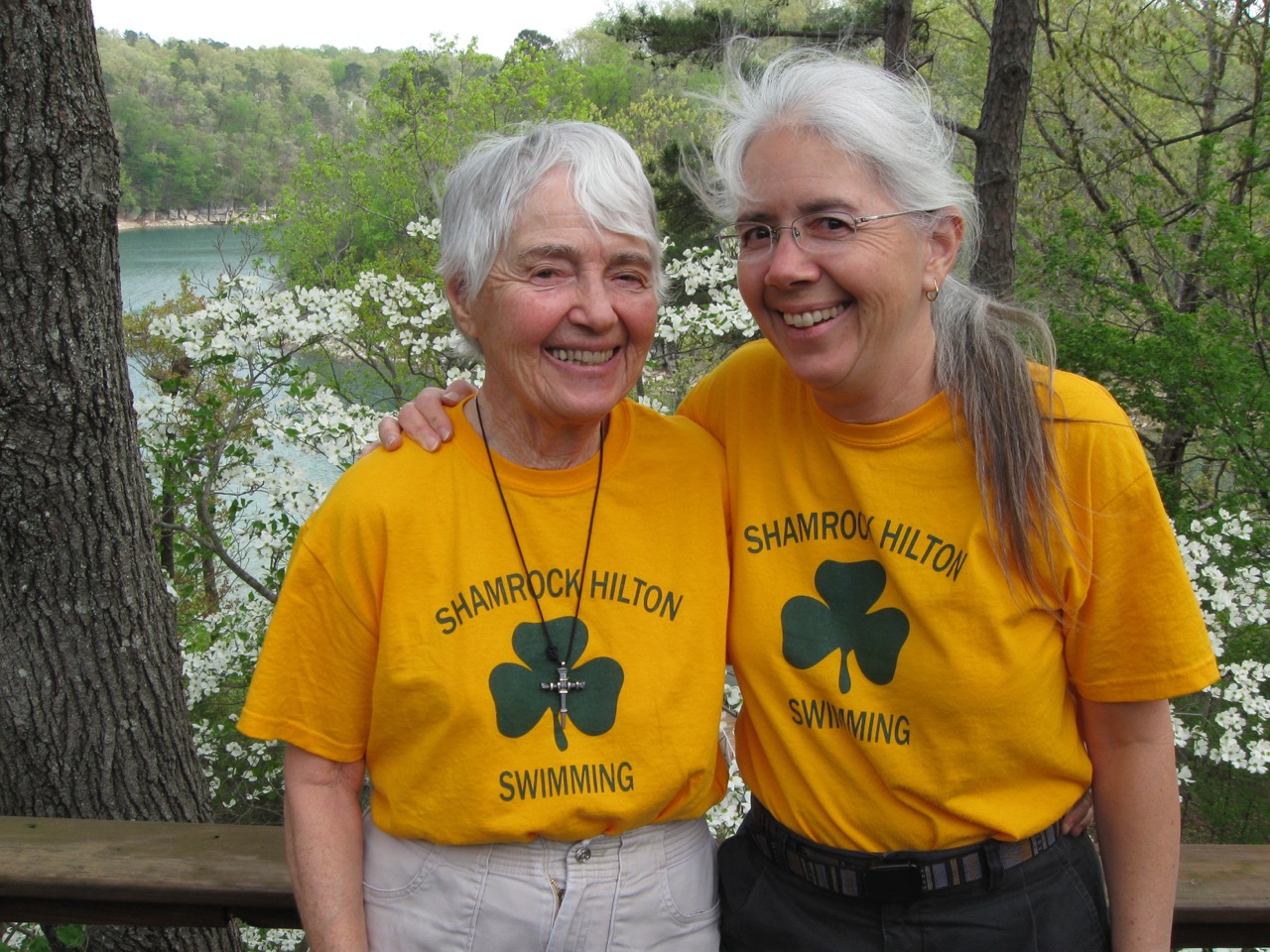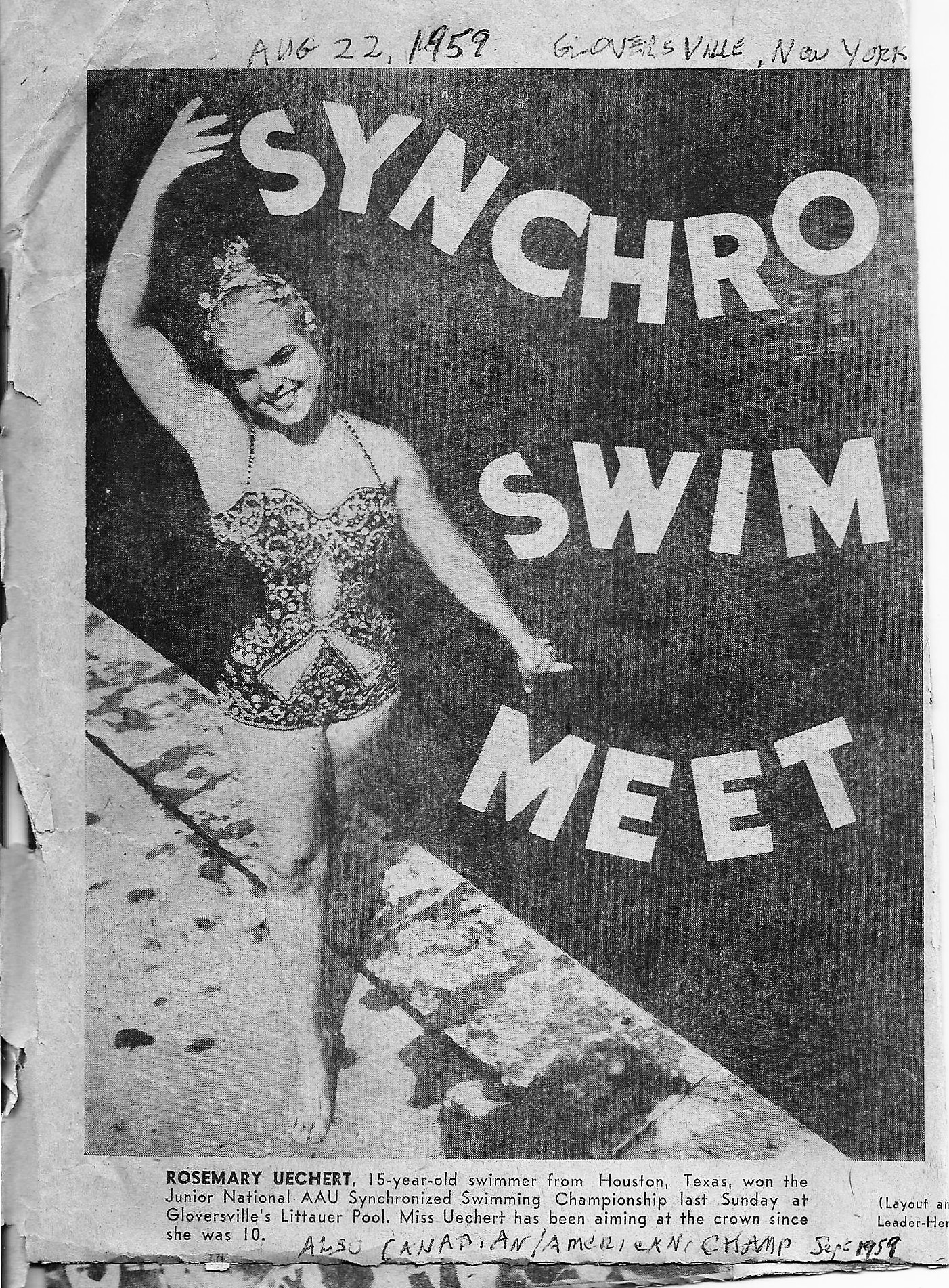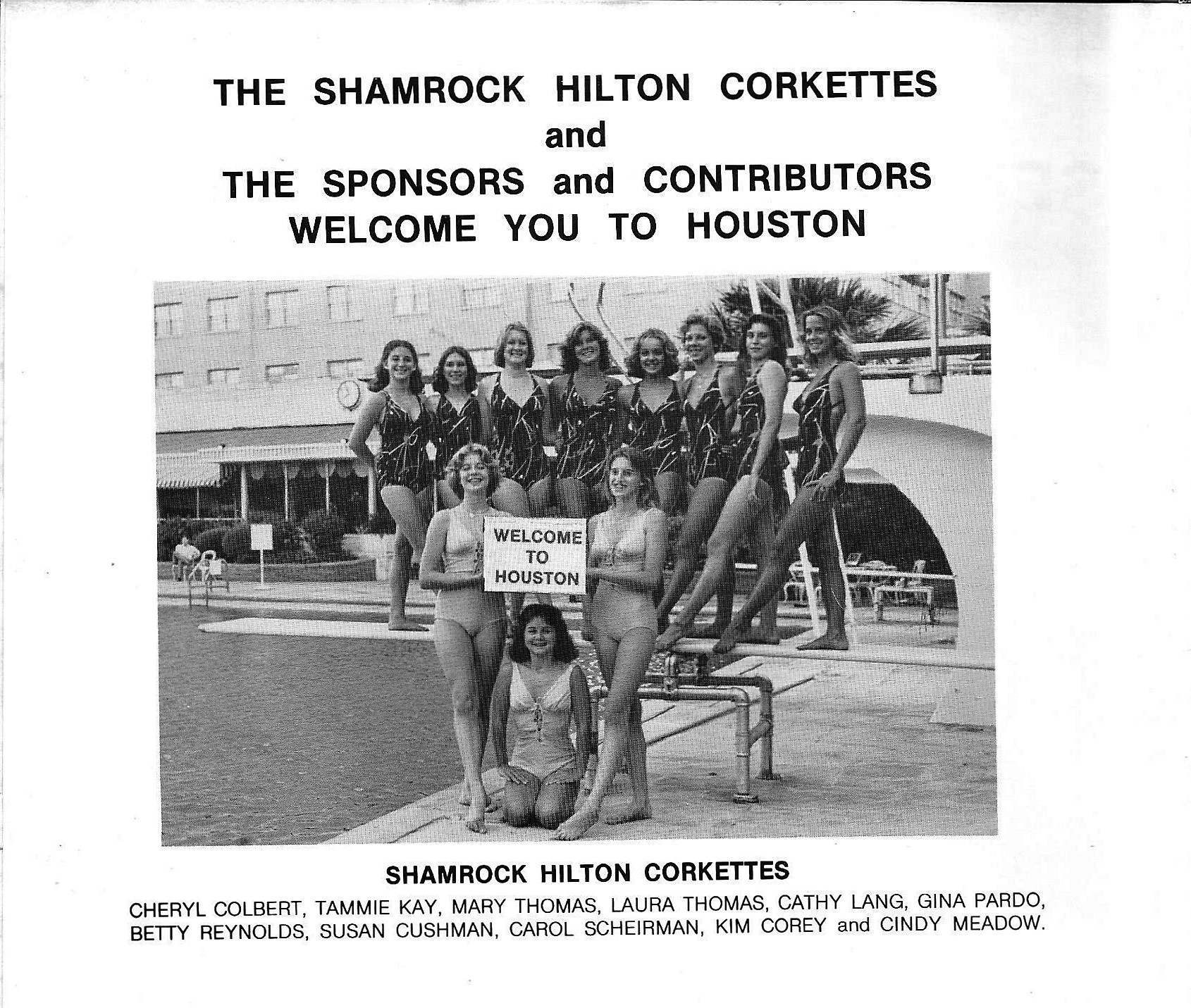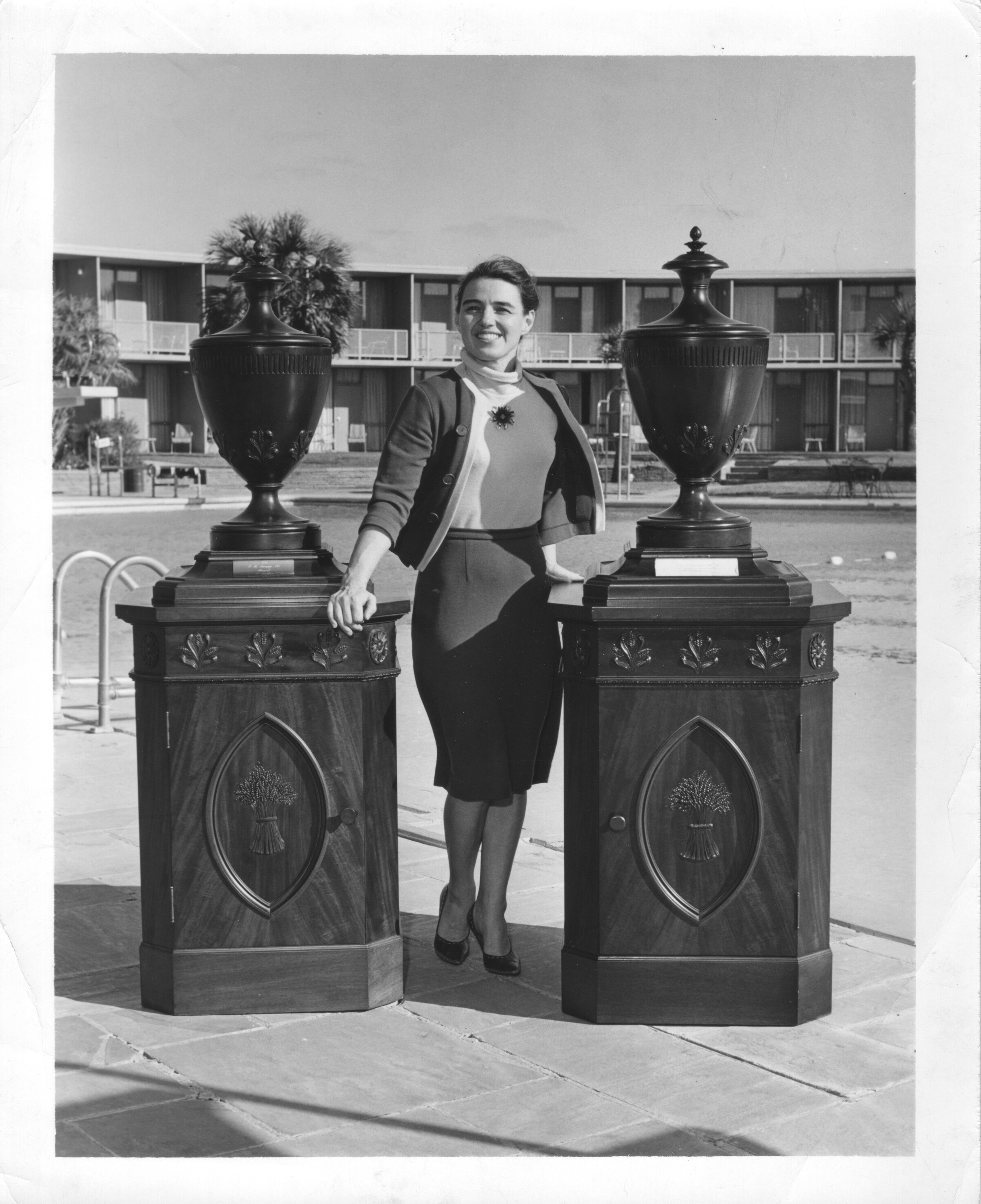Shamrock Hilton
History of the Shamrock Corkettes and Swimming and Diving Teams
For almost two decades the Shamrock Hilton Corkettes synchronized swimming teams took top honors for their disciplined talent and creative teamwork. While the Shamrock swimming and diving teams and their Houston rival Dad’s Club vied for wins at state and national meets. The Shamrock swim teams were special due to the unique combination of motivated athletes, inspired coaches, the unique swimming and diving facilities at the Shamrock Hilton Hotel, and the amazing level of Amateur Athletic Union swimming competition that blossomed in Houston at that time.
The Shamrock Hilton Corkettes
The Shamrock (Hilton) Hotel was built in the 1940s by Glenn McCarthy, designed by Fort Worth architect Wyatt C. Hedrick and opened on St. Patrick’s Day in 1949. The 18-story hotel contained a 1,000-car garage and a 25,000 square-foot exhibit hall. On the south was the hotel’s lavishly landscaped garden designed by Ralph Ellis Gunn, a terrace and an immense swimming pool measuring 165 by 142 feet and described as the world’s biggest outdoor pool. It accommodated exhibition waterskiing and featured a three story-high diving platform with an open spiral staircase. The art deco design inside gave a nod to McCarthy’s ancestral Ireland, using 63 shades of green. The “club” on the top floor was named the Cork Club (so mixed drinks could be served). McCarthy was so impressed at a float he had made that he, as King Neptune, asked to be pushed by the synchro swimmers at the opening Gala. Those swimmers he later dubbed as Corkettes were sponsored for training, travel to competitions and competitions hosted at the pool for over 30 years.
The Shamrock Hotel was sold to the Hilton Hotel chain in 1955. The synchro team, under Joy Cushman, retained their relationship with the Shamrock Hilton Hotel as the Corkettes through negotiations by Cushman (looking like bobbing corks since there was no more Cork Club). The dive team continued in “water shows” and training at the pool in the summer under Kuni Schultz and Nancy Duty. The Shamrock Swim Team shared the pool with the divers and synchro swimmers in the summer, but all had to find warm water for the winter months in various Houston area pools.
In 1949 and 1950 the pool hosted the National A.A.U. Junior Olympic Swimming and Diving Championships. The Junior Olympic Age Group Swimming and Diving Championships started in 1949 at the Shamrock with a paired competition in Chicago. The Shamrock Hilton Hotel hosted many swimming and diving competitions over several decades. The Corkettes hosted at the Shamrock Hilton: five National Synchronized Swimming Championships; seven Junior Nationals, including Junior Olympics; and the Olympic Team Trials for Diving, in which Pat McCormick won. A Shamrock diver, Nancy Duty, missed the team by one hundredth of a point. Nancy Duty Cunningham was inducted into the TSDHOF a couple of years ago. Thanks to the Shamrock, their beautiful pool, and sponsorship, both Nancy Duty and Joy Cushman have been recognized in TSDHOF. They always coached for free.
The (Shamrock Hilton) Corkettes were formed in 1949 at the hotel with Joy Cushman demonstrating her synchronized swimming skills at the opening Gala. In 1950 Joy became the coach and by 1955 she was the National AAU Synchronized Swimming Chair and held that position for five years. The Corkettes placed in the finals of senior and junior national championships for many decades. The synchronized swimmers, divers, clown divers, and dancers performed at every convention banquet and cocktail party held at the hotel poolside – earning funds for the teams to travel to competitions. International synchronized swimmers from many countries were hosted by the Corkettes, with Joy’s national official positions, international connections and hospitality. A nationally ranked synchro Corkette duet was privileged to travel with the USO around the world demonstrating synchronized swimming. The Shamrock Hilton Corkettes were known nationally and internationally. It took many years before the sport of synchronized swimming spread to enough countries to be accepted into the Olympic Games. Pan American and World Championships came first with Joy Cushman’s influence and connections.
The Beginning of the Shamrock Swim Team
Phill Hansel (New Orleans, Louisiana) met Jan Metcalf (Toronto, Canada) in 1948 when they both attended swimming teaching/coaching programs in Florida. They soon married and began promoting swimming and water safety together. Jan almost drowned as a teenager, so teaching children and adults to swim was her passion. Phill excelled at motivating competitive swimmers to set high goals and strive to achieve them.
In 1956, they lived in Portland, Oregon, where Jan ran a swim school and Phill coached the Multnomah Swim Club, which included several world-class swimmers and Olympian Maureen Murphy. Bill Baker from the Dad’s Club and several Houston families recruited Phill in an effort to improve the competitive landscape for swimming in Houston. Concurrently and not coincidentally, the University of Houston Athletic Department hired Phill in 1956 to start their swimming program.
In the summer of 1957, the Shamrock team started with about 20 swimmers and grew into one of the strongest teams in the region. The team was kick-started to greatness by an unexpected problem. When the new University of Houston swimmers arrived, their dorm rooms weren’t ready, so they had no place to live. Jan encouraged each Shamrock family to “adopt” a university swimmer temporarily, and these speedy swimmers worked out with and inspired the young members of the new Shamrock team.
Since the Shamrock Swim Team only had one main coach, the team’s success reflected Phill’s philosophy to motivate swimmers to do their best and still have fun. He challenged everyone to set ambitious goals, work diligently and celebrate reaching the target. His goofy sense of humor and playful poolside antics were welcome diversions during seemingly endless workouts. Jan was the team manager, documented swim meet results for the local papers, and provided valuable “behind the scenes” support for the team in addition to running the Phill Hansel Swimming Academy. Motivated age group coaches such as Gene Shumway, Fred Brechwold and Mike Stevens brought expertise and talented young swimmers to the team. In the mid 1960s around 120 Shamrock swimmers sliced through the water in their green and gold suits.
The Pools
The world famous Shamrock Hilton pool was 50 meters long and fanned out so wide at the shallow end that a motorboat could pull water skiers. The deep end featured two one-meter diving boards, two three-meter boards and a stacked five- and 10-meter platform. Astronauts, celebrities and vacationers were the audience during workouts. Finding an indoor pool for winter workouts was a creative challenge. Bellaire High School, Phill Hansel Swimming Academy, and Gateway indoor pools provided training venues in the winter. In the spring, an innovative “100 Miles in May” program challenged swimmers to readjust to the cold water in the huge Shamrock pool by swimming more than thre miles a day every day of the month, not missing any workouts. That marathon accomplishment was celebrated with an awards breakfast and a Shamrock shaped patch that could be sewn on the team swimsuits or jackets.
In the late '60s, the team began working out during the winter at the Sharpstown Country Club’s 50-meter pool with diving facilities. Coach Hansel pioneered using a large, air-supported vinyl “bubble” over the pool – the first of its kind. The team, known as the Houston Swim Club starting in the early '70s, qualified seven swimmers for national meets and continued to lead in Houston competitions. Unfortunately, the Sharpstown Country Club closed around 1975 and the team held a farewell banquet soon after. Many swimmers joined other Houston teams and Coach Hansel turned his attention full time to building the University of Houston Swim program.
Legacy
Phill and Jan Hansel worked tirelessly to promote swimming throughout the city of Houston with AAU teams and parks department competitions. Jan initiated the “E.A. Snapp and Lillian Shakespeare Awards” for the top boy and girl swimmer in the Houston Area to bring visibility to the vibrant swimming community. She also served as the Houston Chair for Texas Age Group Swimming. In the '60s, Phill Hansel organized and was elected the first president of the American Swimming Coaches Association, which brought additional recognition to the strong program in Texas. Many boys – and girls after Title IX legislation – were recipients of college swim scholarships thanks to the strong swimming environment in Houston. Coach Phill Hansel was inducted into the Texas Swimming and Diving Hall of Fame in 2009 and died in 2010. Jan (Hansel) Muetzel moved to Rogers, Arkansas, in 1972 where she is still working to promote swimming education and is the president of the North West Arkansas Water Safety Council. Shamrock swimmers and divers Gene Shumway, Joy Cushman, Nancy Duty Cunningham, Cynthia Potter and John Vogel have all been inducted in the TSDHF, which is a testament to the caliber of people who made the Shamrock swimming, diving and synchro teams successful.
The Swimmers
Many members of the Shamrock Swimming and Diving Team made great contributions to swimming history. Carin Cone was a 1956 Olympic medalist who swam on both the Shamrock and University of Houston teams and set several world records. Diving champion Cynthia Potter won many national championships, represented the United States on four Olympic teams and then became known for her excellent TV commentary on the sport of diving. In 1966, Coach Hansel entered his men's and women's Shamrock teams into the AAU long distance championships held in Lake Ponca in Ponca City, Oklahoma. His team made a clean sweep and won both national team titles. The Shamrock team included talented, record-setting swimmers almost too numerous to mention and many, many more who showed up for every workout and did their best.
The Divers
Nancy Duty Cunningham was a diver at the Shamrock Hilton under Coach Bob Martin. In 1957 as the Shamrock Swim Team formed, she became the coach of the Shamrock Diving Team. She was the first coach of both four-time Olympian Cynthia Potter and 1976 Olympian Melissa Briley Mieras. She has coached national champions and all-Americans Scott Pyle, Kelly Jenkins, Tom Neyland, Terri Seipel, Barbara McCarthy, and many others. Nancy continued coaching at the Shamrock until 1973 when she became the aquatics director and diving coach for the Jewish Community Center in Houston.
Swim Team Stories, Quotes and Memories
"I joined the Corkettes (100 strong) in the fall of 1955, swam in many of the Shamrock water shows and competed in the 1958 National AAU Outdoor Synchronized Swimming Championships at the Shamrock Hilton among many national championships. After competing for four years in many local and national championships across the country (sponsored by the Shamrock Hotel), I became a coach for the Shamrock Hilton Corkettes in 1962 and was the meet manager for the 1971 Senior National AAU Synchronized Swimming Championships at the Shamrock Hilton Hotel. I am proud to have been a part of the Corkettes (the oldest synchro team in Texas), with many fond memories of the synchro team and the hospitality of the hotel. My daughter also swam as a Corkette in the early 1980s. Several of the Corkettes are currently coaching synchronized swimming in Austin and San Antonio. Many others have continued with national positions in the sport as a result of their beginning at the Shamrock. As a result of my relationship with Joy, the Corkettes, the Shamrock, the AAU and USSS I have donated all my time as a coach to local and national organizations in the sport. I have paid for all of my travel and time in many official positions in the local teams, synchro organizations in the AAU and USSS nationally – regionally – Junior Olympics – and locally for 60-plus years. This sport is fantastic and I owe all my training and encouragement to Joy Cushman and the Shamrock Hilton Corkette experience." - Jeanette Knapp Chase
“Memories of team camaraderie, long bus rides to distant meets, endless circle laps, flip turns, blurry eyes (before swim goggles), sun-bleached greenish hair come to mind whenever I smell chlorinated pool water.” - Ginger Hansel
“My memories include:
My mom taking me at the age of six to have a swim lesson with Mr. Hansel (as I always called him). He worked on my starts and had me practice against Marsha Anderson. The next thing I knew I was on the team and had a cute new swimsuit!
Dedicated parents willing to drive me across town to get me to workouts with the best coach
Exercising with an Exer-Genie, which now would be considered primitive
Aqua logs (created by Mr. Hansel) that were for tracking workouts and included pages of age group rankings. Was always fun to see your name in print.
100 miles in May and being so proud of the patches I got that my mom would sew on my swim jacket.
The many laps/miles Mr Hansel walked along the side of the pools during workouts and swim meets
Mr Hansel's birthday where he would swim a lap for every year old. I so could not do that now!” - Teri Dee Martin
“So around age seven or eight, I had been taking swimming lessons at the Rice University pool, and the instructor there told my mother that he thought I had some potential as a swimmer. The next thing you knew I was trying out for the Shamrock Hilton swim team. When we got to the pool I saw that it was bigger than any pool I had ever seen. It seemed as long and wide as an ocean. The assistant coach, who I think was named Fred (Breckwoldt), told me to get in and swim one length of the pool. It was farther than I had ever gone before. I tried and I struggled and finally I reached the shallow end of the pool. (I had started at the deep end.) Completely winded, I started to pull myself out of the water, when Fred said, "Swim back and you're on the team." I think I may have started to cry and my mother said, "Get back in that pool and DO IT!" Those of you who remember my mother will not doubt this story. So I did, and amazingly I made it back to the deep end of the pool without drowning. Thus began my swimming career. Everything else has seemed pretty easy by comparison.” - Mary Ann (Spira) Rose
"Joan Spillane, the 1960 Olympic swimming champion said, “Swimmers and divers are overachievers who work with other overachievers to find their niche so they can let it loose.” This is an inspiring perspective for her to share. In addition, swimmers and divers need hall of fame- and Olympic-caliber coaches, supportive families, and a world-class facility, which was the Shamrock Hilton.
The Shamrock swim team location was not your normal country club pool, college pool or municipal pool. The pool was part of the 1,000-room Shamrock Hilton Hotel, built by the famous wildcatter Glenn McCarthy – the model for the Jet Rink character in the movie Giant. The hotel was built as a world-class hotel in 1949 and became host to many conventions, movie stars, recording artists, professional athletes, and kings and queens. As a young diver practicing at the Shamrock, I was at the hotel when the Beatles stayed there – sheer pandemonium – and saw Anne Margret and many other stars and athletes at the pool. I remember the day a black limousine pulled up with a 16-foot blue diving board strapped to the roof. The eccentric car owner was shocked when she arrived for her diving lesson to find that there was no diving board because it had been taken across town for a meet the previous day. She went to recover it with her car and returned it to the Shamrock for her lesson.
The 18-story hotel was almost my entire life from 1962 until 1966 when I received a diving scholarship to the University of Texas. I trained as a diver full time with Nancy Duty. The other divers and I would train with Nancy between 10am and 4pm on summer weekdays and then go to diving meets on many of the weekends. If we were lucky we got to ride with Nancy in her newest T-bird.
During that time of my life, I shared my days with many of the overachievers Joan Spillane referred to: divers Cindy Potter, Melissa Briley, Barbara McCarthy, Scotty Pyle, Rick Grey, Larry Jones, Chuck and Freddie Machell, Ann Little John – all talented and fun people; coaches Nancy Duty, Phil Hansell, and Joy Cushman. Years later I was mentored in the home-building business by an original Shamrock diver, Bob Brodnax, who in his diving career ranked second in diving nationals and was Southwest Conference diving champion four times. Bob dived on opening night of the Shamrock Hilton.
The divers were a spirited and energetic bunch, and Nancy Duty and Phil Hansell, in addition to their coaching duties, kept us in control and out of trouble with the hotel management. They were great role models and inspirations to us all.
I rode my bicycle four miles to the Shamrock for my first diving lesson with Nancy Duty, and the view of the landscape and pool was jaw-dropping. From that day the hotel became my life away from home. Besides being on the diving team, I worked behind the check-in desk and as a banquet waiter in the ballroom. I could greet the guests upon arrival, serve them baked Alaska in the ballroom after dinner, then present them with “Barbecued Texan” at the evening pool extravaganza as I did the fire dive from the tower. Those Shamrock Hilton days were really something!" - Tom Neyland
From Guy Hagstette:
"Growing up here in the 1950s and 1960s, “Houston” and “Glamour” were two words rarely used in the same sentence. My parents settled here in 1953 after a stint with the CIA in Europe, and of course they gravitated to one of the few places in this sleepy Southern town that offered world-class entertainment and, yes, glamour — the Shamrock Hotel. It had only opened four years earlier to great national attention — so much that its opening was the finale of the Hollywood blockbuster, “Giant.”
Some of my earliest memories as a young boy are Easter egg hunts outside the Emerald Ballroom where my parents also went to dance without the kids in tow. The hotel lobby was flanked by Neiman Marcus and Sakowitz shops competing for the attention of visitors to Houston. There was a Trader Vic’s ready to transport you to the South Pacific.
And then there was the pool — the world’s largest hotel swimming pool — 55 yards long and almost as wide. Big enough to host water skiing exhibitions. A 10-meter platform for Olympic diving. Palm trees and cabanas. You could go there and pretend you were on the French Riviera, complete with dashing pilots and beautiful stewardesses staying over between flights connecting Houston to Europe.
My family joined the Shamrock Swimming Team in 1965, which at the time was the best in Texas. Swimming workout for a 10-year-old was like being in the ocean (there were no lanes back then), and meets were legendary as both the pool and hotel were taken over by legions of swimmers and their overzealous parents.
Like Houston, the Shamrock was not perfect. Upon seeing it, Frank Lloyd Wright’s reaction is said to have been simply, “Why?” Its green tile roof and bulky brick exterior were not on the cutting edge of modern architecture, but it did a splendid job of marking the terminus of Houston’s civic axis on South Main Street. It also captured the spirit of a young Texas city on the move as it sought to break out of its old South background to become the global city it is today.
The Shamrock has been gone for a quarter century now, and in typical Houston fashion, all they kept was the parking garage. Like hundreds of Houstonians, I “Rallied Round the Rock” in a futile attempt to call attention to what Houston would lose when it was torn down. The claim was the Texas Medical Center needed the land for expansion, and who could argue with that? But 26 years later, the World’s Largest Hotel Swimming Pool is nothing but an asphalt parking lot.
When the Shamrock was demolished, we lost a little bit of what makes Houston unique, a lesson we should consider as arguments are made that the Astrodome, another icon of mid-20th century Houston, also should be reduced to an asphalt parking lot. I can only hope we have learned from our past mistakes."






















































